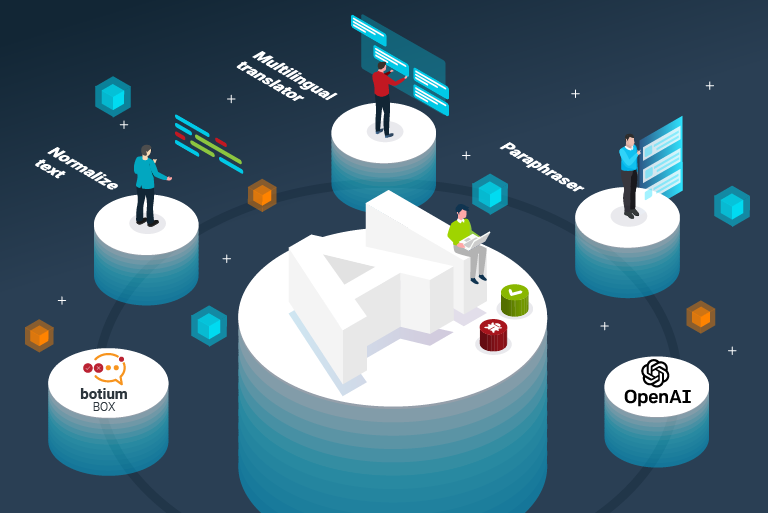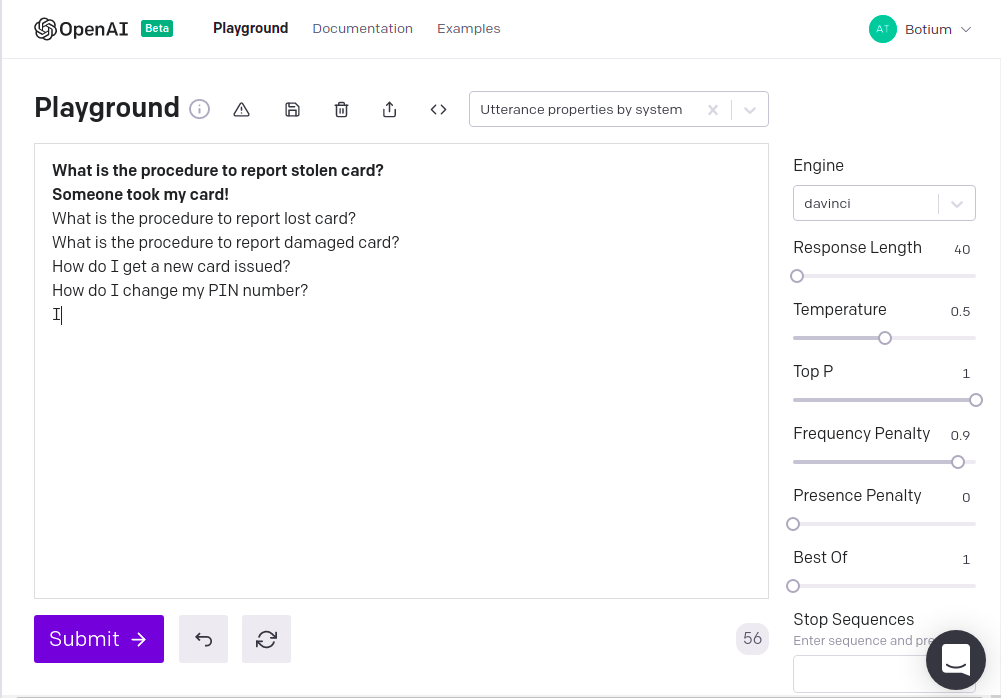
All chatbot testers are dreaming of two buttons. One for detecting all problems of a chatbot, and another one for fixing them all.
With OpenAI we were able to add some nice features to Botium Box which are going in that direction.
- We are using Open AI to guess what can be the next message in conversation
- We integrated a new, multilingual paraphraser which takes the risk while generating new alternatives.
Here are some tips and usecases that we learned while developing those features.

Normalize text
Documentation of OpenAI says that it is better to check spelling mistakes in text. But we can go on. Text has to be as strict as possible. Some samples:
- Avoid using enters. For example we can confuse OpenAI if we allow new line in the “human” section of a chat.
- Terminate the sentences with dots. (OpenAI will deal with it as a sentence, won’t continue it for example)
- Avoid unnecessary information. For example we distinguish between user writes the text “pizza”, or just pushes the “pizza” button. Second one is something like this: “#user button:pizza” for us. But this information can be confusing for OpenAI, it’s better to use just “#user pizza”.
Trending Bot Articles:
2. Automated vs Live Chats: What will the Future of Customer Service Look Like?
4. Chatbot Vs. Intelligent Virtual Assistant — What’s the difference & Why Care?
Use enter on the end of the prompt correctly
This:
"Human: Hello, who are you?
AI: I am an AI created by OpenAI. How can I help you today?
Human: Can I ask you"
and this:
"Human: Hello, who are you?
AI: I am an AI created by OpenAI. How can I help you today?
Human: Can I ask you
"
is a big difference for OpenAi, but it is just an extra enter. In the first case OpenAI continues the human message, in the second it generates new AI message.
Multilingual translator
Building a multilingual translator is not difficult. There is a sample for translator in Open AI playground. We can use the same parameters and datastructure, but with multilingual samples:
English: See you later!
French: À tout à l'heure!
German: Ich möchte Geld überweisen.
English: I want to transfer money.
Russian: Я хотел бы заказать пиццу.
German:
That works well, but we have to define explicitly the language of the source text. We will overcome this restriction in the next step.
Multilingual translator, basic language is not specified
In order to do it, we have to restructure the prompt a bit:
Text: See you later!
LanguageOfResult: French
Result: À tout à l'heure!
Text: Ich möchte Geld überweisen.
LanguageOfResult: English
Result: I want to transfer money.
Text: Я хотел бы заказать пиццу.
LanguageOfResult: German
Result:
But lets play with it a little bit more
Multilingual translator and language detector
If we add a new field, then we can ask OpenAI for language detection:
Text: See you later!
LanguageOfResult: French
Result: À tout à l'heure!
LanguageOfText: English
Text: Ich möchte Geld überweisen.
LanguageOfResult: English
Result: I want to transfer money.
LanguageOfText: German
Text: Я хотел бы заказать пиццу.
LanguageOfResult: German
Result:
It is a nice experiment. Sadly it does not recognize language always good, but reveals us some facts:
- It is possible to teach OpenAI parameters (Text, LanguageOfResult), and return values (Result, LanguageOfText) Of course they are not parameters, and return values for OpenAI, but for us.
- OpenAI can solve more complex tasks. What is a two step solution for us, it is maybe not for OpenAI.
Paraphraser
Sure, there are more ways to create a prompt for a parapraser. There is no best solution, each has its own pros, and cons. Our paraphraser is very simple, but it does what we need.

Pros:
- It is open, it finds really nice new alternatives.
- Prompt is just 2 rows (less cost)
- It is not stuck to any language. (Some prompts, like our translator have a training section, and a request section. If we create some ‘hard coded’ training sections to paraphrase in english, then we get a request to paraphrase german sentences, then we will have a prompt in multiple languages. It can be misleading for OpenAI)
Cons:
- About half of the result is not a good paraphrasing. But it does not mean that it’s worthless! If we got “Can I replace my card if it is lost or stolen?” for “Someone took my card!” and “What is the procedure to report stolen card?” then we see that it does not fit. But in our case for a Banking chatbot it can indicate a new use case.
Don’t forget to give us your 👏 !




OpenAI GPT-3 tricks and tips was originally published in Chatbots Life on Medium, where people are continuing the conversation by highlighting and responding to this story.